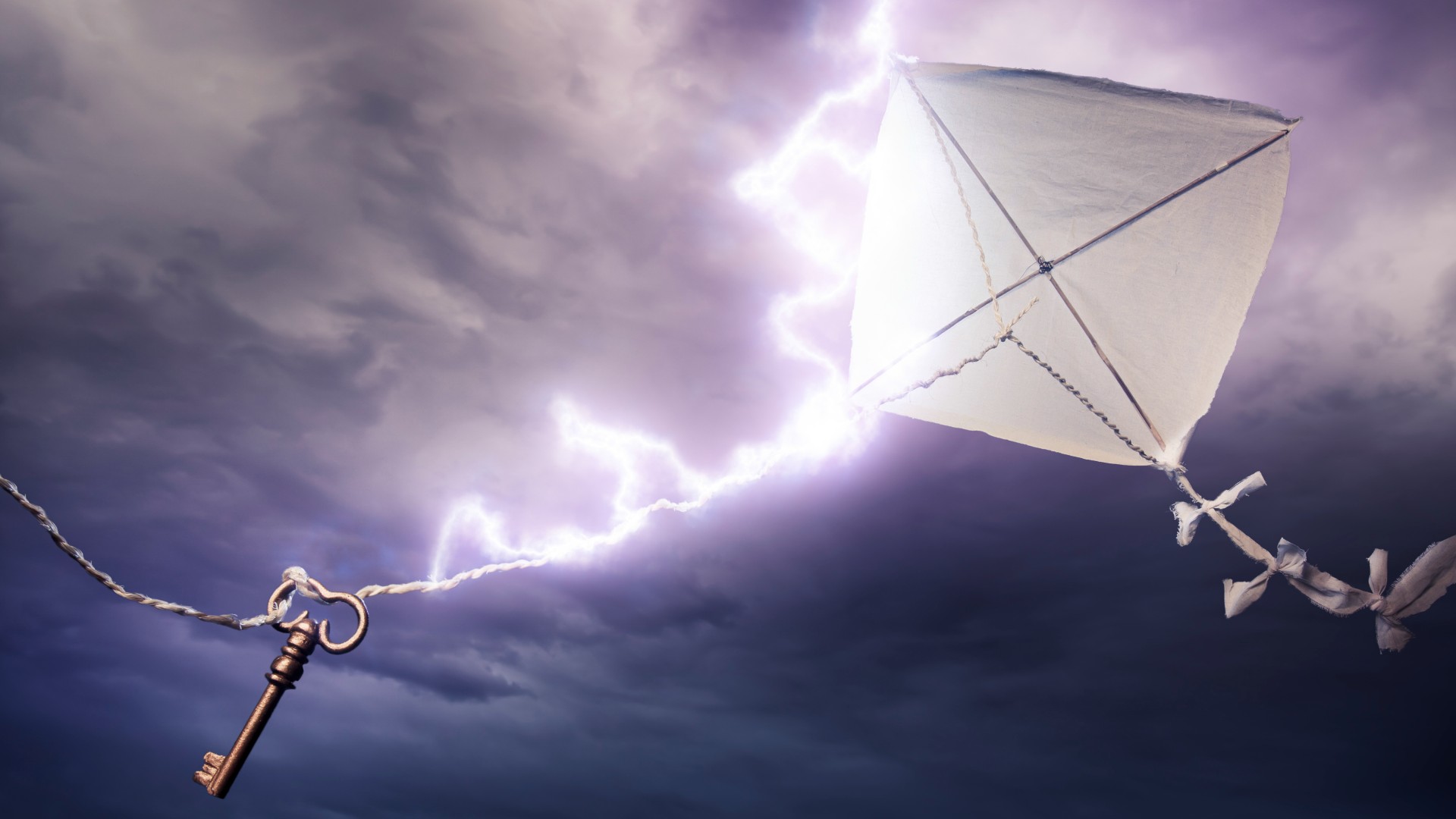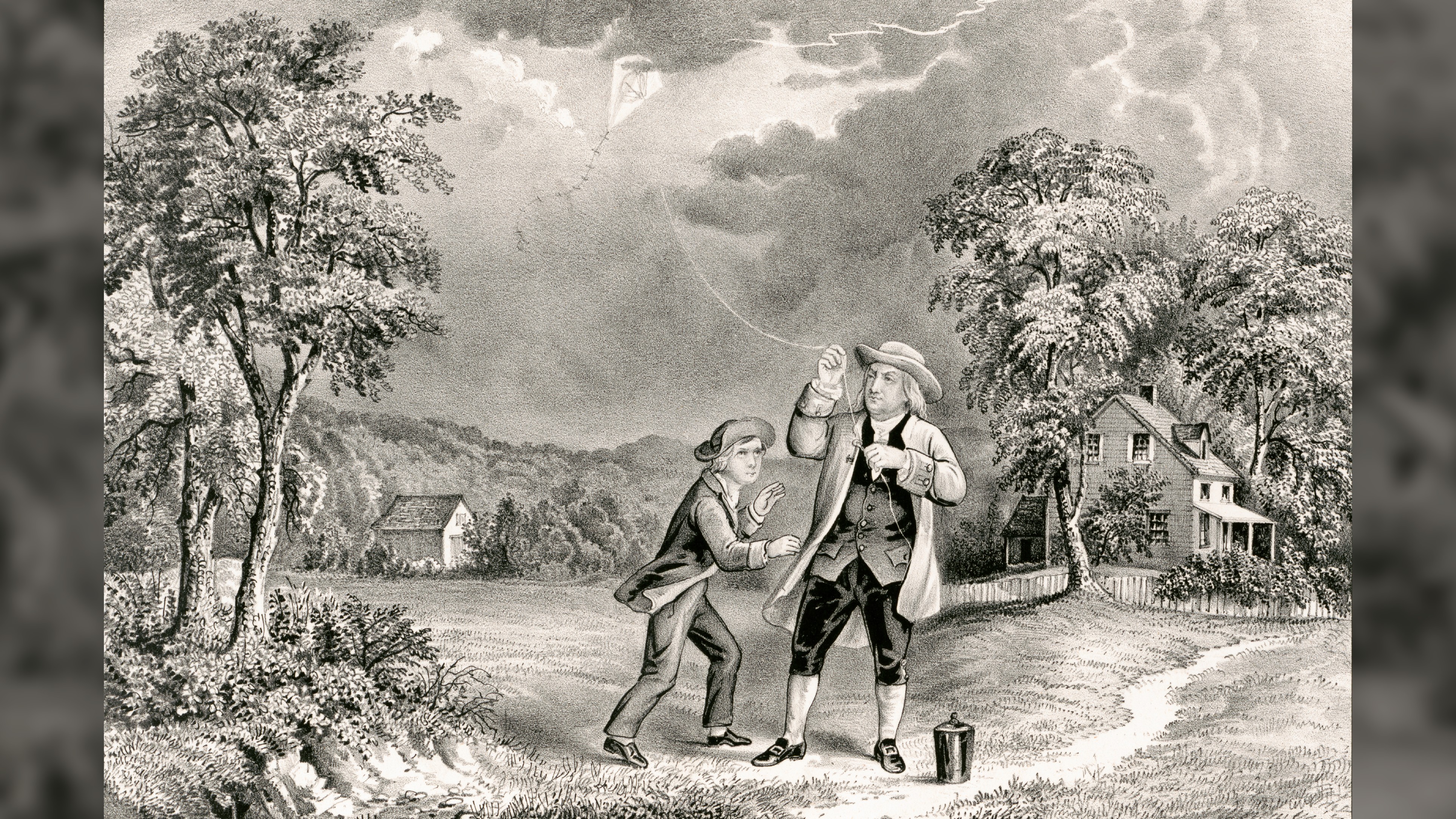Did Benjamin Franklin really discover electricity with a kite and key?
Did the founding father really discover electricity?

On a dark, stormy summer night in 1752, Benjamin Franklin flew a kite with a key attached to the string waiting in anticipation for lightning to strike. The dramatic bolt would harken the discovery of electricity (or as Franklin called it "electrical fire") … or so the story goes.
But is there any truth to this tale? Did Franklin really discover electricity by getting zapped by a lightning bolt during this experiment?
Though most people know Benjamin Franklin — an American founding father, legendary statesman and the face of the U.S. $100 bill — for his political contributions, Franklin was well known in his time as a scientist and an inventor: a true polymath. He was a member of several scientific societies and was a founding member of the American Philosophical Society. As a result, he stayed informed on the most pressing scientific questions that occupied learned people of his time, one of which was the nature of lightning.
As for the kite-and-key experiment, most people are aware of the version in which the metal key acted as a lightning rod, and Franklin subsequently "discovered" electricity when lightning struck his kite. However, several details about this experiment are unknown, including when and where it happened. Some historians even doubt that it took place.
Related: Did Benjamin Franklin really want the turkey to be the US national bird?
For starters, it's a common myth that Franklin discovered electricity. Electricity had already been discovered and used for centuries before Franklin's experiment. Franklin lived from 1709 to 1790, and during his time, electricity was understood as the interaction between two different fluids, which Franklin later referred to as "plus" and "minus." According to French chemist Charles François de Cisternay du Fay, materials that possessed the same type of fluid would repel, while opposite fluids attracted one another. We now understand that these "fluids" are electrical charges generated by atoms. Atoms are made up of negatively charged electrons orbiting a positively charged nucleus (made up of protons and neutrons).
It was unknown prior to Franklin's experiment whether lightning was electrical in nature, though some scientists, including Franklin, had speculated just that. Page Talbott, author and editor of "Benjamin Franklin: In Search of a Better World" (Yale University Press, 2005) and the former president and CEO of the Historical Society of Pennsylvania in Philadelphia, said that Franklin was particularly interested in this question because lightning strikes had caused disastrous fires in cities and towns where houses were made of wood, which many homes in the U.S. were at the time.
"By attaching a key to the string of a kite, thus creating a conductor for the electrical charge, he was demonstrating that a pointed metal object placed at a high point on a building — connected to a conductor that would carry the electricity away from the building and into the ground — could make a huge difference to the long-term safety of the inhabitants," Talbott told Live Science in an email. In other words, by creating a lightning rod, Franklin was helping to protect wooden homes and buildings from being directly struck by lightning.
Get the world’s most fascinating discoveries delivered straight to your inbox.
Lightning rods are metal rods placed at the top of structures, connected to the ground with a wire. If lightning strikes the building, it will likely strike the electrically conductive rod instead of the building itself and safely run through the wire to the ground.
Here's how the experiment worked; standing in a shed, Franklin flew a kite, made of a simple silk handkerchief stretched across a cross made of two cedar strips, during a lightning storm. The tail of the kite was made of two materials — the upper end attached to the kite was made of hemp string and attached to a small metal key, while the lower end, held by Franklin, was made of silk. The hemp would get soaked by the rain and conduct electrical charge, while the silk string would remain dry because it is held under cover.
As Franklin observed his flying kite, he saw that the hemp strands stood on end as they began to accumulate electrical charge from the ambient air. When he placed his finger near the metal key, he reportedly felt a sharp spark as the negative charges that had accumulated on the key were attracted to the positive charges in his hand.
A few publications at the time reported on the experiment. "[Franklin] published a statement about the experiment in the Pennsylvania Gazette, the newspaper he published, on October 19, 1752," Talbott said. He then sent the text of this statement to a patron of the American Philosophical Society named Louis Collinson; Franklin had spent the last few years communicating his theories and proposing his experiments concerning lightning to him.
Franklin referred to the experiment in his autobiography, and other colleagues in Europe wrote about it as well, Talbott said. Notably, the experiment appeared in the 1767 book "History and Present Status of Electricity" by Joseph Priestley, an English chemist. Priestley heard about the kite-and-key experiment from Franklin himself around 15 years after the fact, and in his book, he wrote that it occurred during June 1752. However, exactly when the experiment came to Franklin and when he did it is a matter of debate.
There are some historians who doubt whether Franklin actually did the experiment himself, or merely outlined its possibility. In his book "Bolt of Fate: Benjamin Franklin and His Electric Kite Hoax" (PublicAffairs, 2003), author Tom Tucker stated that Franklin wanted to thwart William Watson, a member of the Royal Society of London and a preeminent electrical experimenter. Watson had sabotaged the publication of some of Franklin's previous reports and had ridiculed his experiments in the Royal Society, Tucker wrote. Could Franklin have felt pressured to invent the kite story to get back at Watson?
Tucker also noted that Franklin's description of his experiment in the Pennsylvania Gazette was phrased in the future conditional tense: "As soon as any of the Thunder Clouds come over the Kite, the pointed Wire will draw the Electric Fire from them..." Franklin could have simply been saying that the experiment could, in theory, be performed. Given that his statement has a few missing details — Franklin didn't list a date, time or location, for example — it's possible that the American diplomat did not perform the experiment himself.
However, some historians remain unconvinced that the experiment wasn't carried out, pointing to Franklin's great respect for scientific pursuits. Franklin experts, such as the late American critic and biographer Carl Van Doren, also point to the fact that Priestley specified the month in which Franklin performed his experiment, suggesting that Franklin must have given him precise details directly.
Originally published on Live Science.

Jacklin Kwan is a freelance journalist based in the United Kingdom who primarily covers science and technology stories. She graduated with a master's degree in physics from the University of Manchester, and received a Gold-Standard NCTJ diploma in Multimedia Journalism in 2021. Jacklin has written for Wired UK, Current Affairs and Science for the People.




